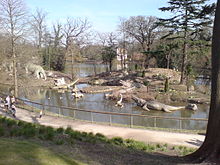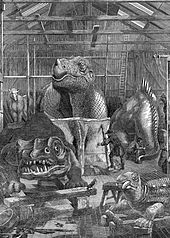- Crystal Palace Dinosaurs
-
Coordinates: 51°25′3″N 0°4′2″W / 51.4175°N 0.06722°W
The Crystal Palace Dinosaurs, also known as Dinosaur Court, are a series of sculptures of dinosaurs and extinct mammals located in Crystal Palace, London. Commissioned in 1852 and unveiled in 1854, they were the first dinosaur sculptures in the world, pre-dating the publication of Charles Darwin's On the Origin of Species by six years. Designed and sculpted by Benjamin Waterhouse Hawkins with the help of Richard Owen,[1] they were Grade II listed buildings from 1973, extensively restored in 2002 and upgraded to Grade I listed in 2007.
The models themselves are now considered out of date and to varying degrees inaccurate.[2]
Contents
History
Following the closure of the Great Exhibition in October 1851, The Crystal Palace was bought and moved to Sydenham Hill, South London by the newly formed Crystal Palace Company; the grounds that surrounded it were then extensively renovated and turned into a public park with ornamental gardens, replicas of statues and two new man-made lakes. As part of this renovation Benjamin Waterhouse Hawkins was commissioned to build the first ever life-sized models of extinct animals. He had originally planned to just re-create extinct mammals before deciding on building dinosaurs as well, which he did with advice from Sir Richard Owen, a celebrated biologist and palaeontologist of the time. Hawkins set up a workshop on site at the park and built the models there.
The models were displayed on three islands acting as a rough time-line, the first island representing roughly the Paleozoic era, a second representing the Mesozoic era, and a third representing the Cenozoic era. All of the mammals on the third island, however, were later moved to other locations on in the park (which in many ways directly led to them falling into ill-repair). The models' realism was aided by the lake at the time being 'tidal' and rising and falling, revealing different amounts of the dinosaurs. To mark the 'launch' of the models Hawkins held a dinner on New Year's Eve 1853 inside the mould of one of the Iguanodon.
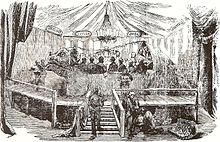 The famous banquet in the Crystal Palace Iguanodon, New Year's Eve 1853.
The famous banquet in the Crystal Palace Iguanodon, New Year's Eve 1853.
Hawkins benefited greatly from the public's reaction to them, which was so strong it led to what could be considered the first case of tie-in merchandising as a set of smaller versions of Hawkins's models were sold for £30 as educational products. But the building of the models was costly (having cost around £13,729) and in 1855 the Crystal Palace Company cut Hawkins's funding, leaving several planned models unmade or half finished and scrapped, despite protest from various sources including newspaper The Observer.
As further and fuller discoveries of the species included in Crystal Palace were made, the reputation of the models declined. By as early as 1895 experts looked on them with scorn and ridicule. The Crystal Palace Dinosaurs by Steve McCarthy and Mick Gilbert quotes American fossil hunter Othniel Charles Marsh who scorns the dinosaurs' 'friends' as doing them a great injustice and speaks angrily of the models. The models and indeed the park fell into ill-repair as the years went by, a process aided by the fire that destroyed the Crystal Palace itself in 1936. The visibility of the models became obscured by overgrown foliage, but a full restoration of the animals was carried out in the 1950s by Victor H.C. Martin,[3] this is when the animals were moved around.
Though general and often ad-hoc maintenance was carried up in the meantime (including the use of plasticine [1]) the dinosaurs did not undergo a full restoration until 2002; during that time the park had fallen into total disarray and at one point a guided tour of the dinosaurs was the only time the park was open to the public. In 2002 the Institute of Historic Building Conservation totally renovated the models, including properly fixing and re-painting the existing models (in much lighter or at times totally different colors, for instance the Megatheirium was changed from blue to beige during the restoration). The institute also had fiberglass replacements created for the missing pterodactyls and their cliff, cutting away a lot of the foliage and restoring the original recreations of plant life that accompanied the models in the 1850s.
The sculptures
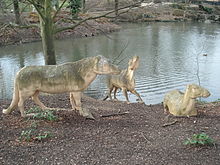 The Anoplotherium herd
The Anoplotherium herd
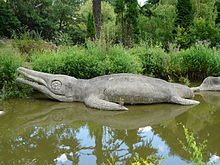 The Ichthyosaurus
The Ichthyosaurus
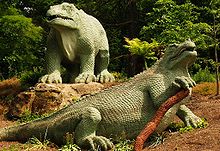 The Iguanodon sculptures
The Iguanodon sculptures
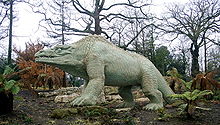 The Megalosaurus sculpture
The Megalosaurus sculpture
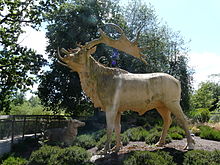 Megaloceros sculptures
Megaloceros sculptures
 The two Teleosaurus
The two Teleosaurus
Fifteen species of extinct creatures currently reside in the park, as well as this at least three other genera (Dinornis, a mastodon, and Glyptodons) were planned, and if contemporary reports are accurate at Hawkins began to build at least the mastodon before the Crystal Palace Company cut his funding in 1855. An inaccurate map of the time, reprinted in Steve McCarthy and Mick Gilbert's book The Crystal Palace Dinosaurs, even gives the planned locations of the Dinornis and mastodon.
The fifteen genera that were completed were:
Anoplotherium An extinct mammal: Hawkins's models draw very much on speculation about its camel-like appearance, and they resemble camels a great deal (it is now believed they look more like hippopotamus or pigs). Three models were originally made, but one, with its head raised, went missing in unknown circumstances but is now back with the other two on display.
Dicynodon Crystal Palace's Dicynodon, of which there are two, are based on fossils found in South Africa which were largely incomplete, as such the models are based heavily on turtles or tortoises complete with a shells and turtle stance. To date there is no evidence of any shelled Dicynodon and recent more complete fossils have revealed they looked more like Hippopotamus.
Hylaeosaurus Curiously, when their names are taken into consideration, it is Hylaeosaurus, not Iguanodon, that most resembles the giant iguana stereotype of early ideas of dinosaurs. Today Hylaeosaurus is depicted similar to Ankylosaurus; Hawkins's depiction is of a large Iguana-like beast with long sharp spines along its back. The head of the Hylaeosaurus model is in fact not the original but a fiberglass replica; the original head is positioned outside the park's visitor's centre.
Ichthyosaurus Though a portion of the three Ichthyosaurus are submerged by water (though early shots show that unlike the Mosasaurus most of the model was completed) they are in fact basking on the land similar to Seals or Walrus do today, something we now know would kill them. In the time of the Crystal Palace Dinosaurs' productions the beasts were considered more along the lines of crocodiles or the Plesiosaurus; recently it has been uncovered they have more in common with sharks and dolphins with a dorsal fin and fish-like tail, both of which are not present in Hawkins's models. Instead the tails are a flat protuberance from a straight backbone. A further discrepancy is that the models' eyes have exposed sclerotic plates (bones that stopped their eyes from being crushed by the pressure under sea). However as a whole the ichthyosaurs are one of the more accurate animals and became one of the three 'mascot dinosaurs' along with the Iguanodon and Megalosaurus (although ichthyosaurs are not dinosaurs at all). The models more closely resemble more basic ichthyosaurs such as Cymbospondylus.
Iguanodon Easily the most recognizable and most commonly shown of Hawkins's models are the pair of Iguanodon. The inaccuracy of having thumb spikes mistaken for horns is used repeatedly on documentaries about dinosaurs and their history when talking about Victorian ideas of the beasts. Aside from this the Iguanodon, like the Megalosaurus, were depicted as quadrupeds (walking on all fours) and look as though they are inspired by modern day dogs.
Labyrinthodon Three Labyrinthodon models were made for Crystal Palace, heavily based on frogs. One is smooth skinned and is based on the species Labyrinthodon salamandroides. Two were based on Labyrinthodon pachygnathus (both have since been re-classified). Casts of the animal's real footprints were included in the ground around the models (one of which had survived by the time of The Crystal Palace Dinosaurs being written).
Megaloceros Hawkins built a whole family unit of male, female and fawn; the adults bore antlers made from actual fossil antlers, though these have since been replaced. Moved from the third island, they had fallen into disrepair as they were in a place easily accessible by vandals. Until their antlers were replaced, the Elks were the most accurate of the models, though given that they are only large deer and stag anyway, there was much more reference for them in 1852.
Megalosaurus Giant and visually impressive even by today's standards, the Megalosaurus became one of the park's three 'mascot dinosaurs' along with the Iguanodon and (less so) the Ichthyosaurs. Yet it is arguably the most inaccurate of all of Hawkins's models, depicted as a quadruped that looks like an elephant with a lizard's head and paws.
Megatherium Wholly more accurate than most of the dinosaur species, the Megatherium was part of the park's children's zoo for many years with its tail in the goats and guinea pigs enclosure. Once the zoo was closed, it became totally inaccessible, only to be seen through the railings that kept visitors out of the derelict area. Recent renovations demolished the zoo and a walkway has caused the Megatherium to become one of the models visitors can now get the closest to.
Mosasaurus At the time of the models being built, only skulls of Mosasaurus had been discovered. In a clever way of disguising this lack of information, Hawkins only built the head and back of the animal. He submerged the model deep in the lake so the water hid this fact, leaving little room for inaccuracy. Despite this it does look noticeably different from modern reconstructions of the beast. The Mosasaurus at Crystal Palace is positioned in an odd place near the secondary island that was originally a waterfall, and much of it is obscured if viewed from the lakeside path.
Palaeotherium The herd of Palaeotherium, an extinct tapir-like mammal, have suffered the most ill-repair of all of the models, and the standing model looked very little like the original model by Hawkins; prior to the 2002 restoration they were in such bad shape they were removed totally and were stored with miscellaneous equipment.[2] They have since been restored and put back on show but still show surface wearing. Some sources state that these models were added at a later date but a London News illustration of Hawkins's workshop clearly shows them in the background, appearing to prove these sources inaccurate.
Plesiosaurus Each of the three plesiosaur models are intended to represent a different genus, and generally are fairly accurate to today's standards with the exception of two models' incredibly flexible necks, which twist in nearly impossible ways.
Pterodactyl The most common way of someone drawing a pterodactyl is to give the animal a head with an additional point, making its head almost symmetrical to its beak, but there were species of Pteranodon that had simple bald heads devoid of these points. Hawkins's pterodactyls are some of his more accurate models (again despite their pipe-cleaner style necks). At some point the two models that stood beside the Iguanodon on the central island went missing; they have since been restored in the recent 2002 renovations.
Teleosaurus Arguably Hawkins's most accurate model, the two Teleosaurs are depicted virtually the same as they are today (thin crocodiles with very long thin jaws and small eyes).
In Literature and popular culture
In the children's book Dinosaurs Don't Die a young boy who lives near Crystal Palace Park discovers Hawkins' models come to life; he befriends one of the Iguanodon and names it 'Rock' and they visit the Natural History Museum. Brett Anderson, used the line 'So I went and sat in Crystal Palace, by the plastic dinosaurs' on his solo track To The Winter, from his 2007 self-titled album. In Have His Carcase, by Dorothy Sayers, character Lord Peter Wimsey makes reference to the "antediluvian monsters" of the Crystal Palace. In Paul Theroux's 1989 novel My Secret History, the novel's narrator, Andre Parent, accidentally learns of his wife's infidelity when his young son, Jack, reveals to his father that he has visited the dinosaurs in the company of his mother's "friend" during Andre's prolonged absence gathering material for a travel book. The Dinosaurs of Waterhouse Hawkins: An Illuminating History of Mr. Waterhouse Hawkins, Artist and Lecturer (Hardcover) by Barbara Kerley (Author), Brian Selznick (Illustrator).
References
- ^ Natural History Museum biographies Richard Owen
- ^ Smith, Dan (26-February-2001). "A site for saur eyes". New Statesman. http://www.newstatesman.com/200102260031. Retrieved 2009-06-21.
- ^ Mayor of London (July 2008). "Consultation Draft: Geodiversity of London". http://www.london.gov.uk/mayor/planning/docs/geodiversity-draft-maintext.rtf. Retrieved 2009-07-01.[dead link]
Sources
- The Crystal Palace Dinosaurs by Steve McCarthy and Mick Gilbert, originally published 1994 by the Crystal Palace Foundation.
- Nyder's Diner's Crystal Palace Dinosaurs Page
- IHBC's archive on their 2002 restoration of the models
- BBC feature
Categories:- 1854 works
- Buildings and structures in Bromley
- Grade I listed buildings in London
- Dinosaur sculptures
- Outdoor sculptures in London
- Visitor attractions in Bromley
- Paleoart
- Sculpture series
- 19th-century sculptures
Wikimedia Foundation. 2010.

